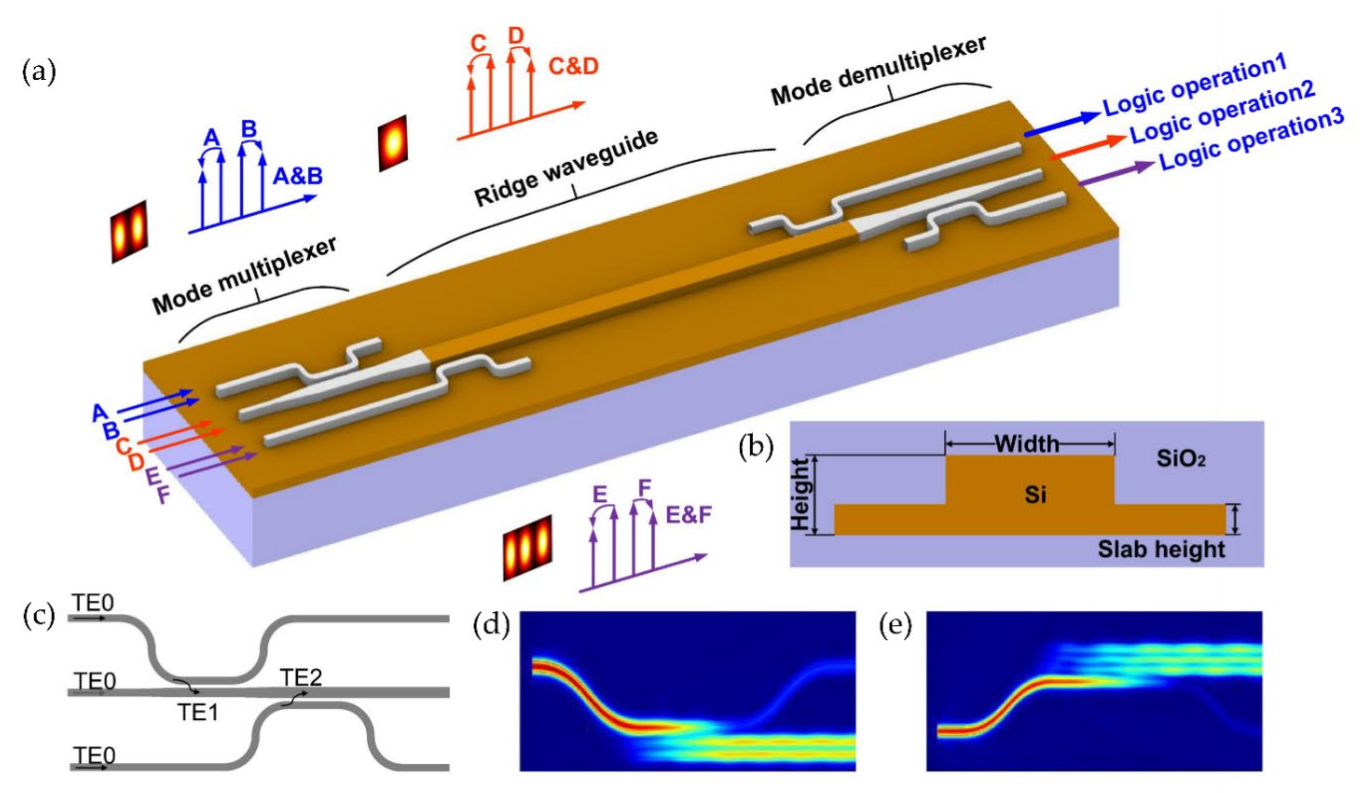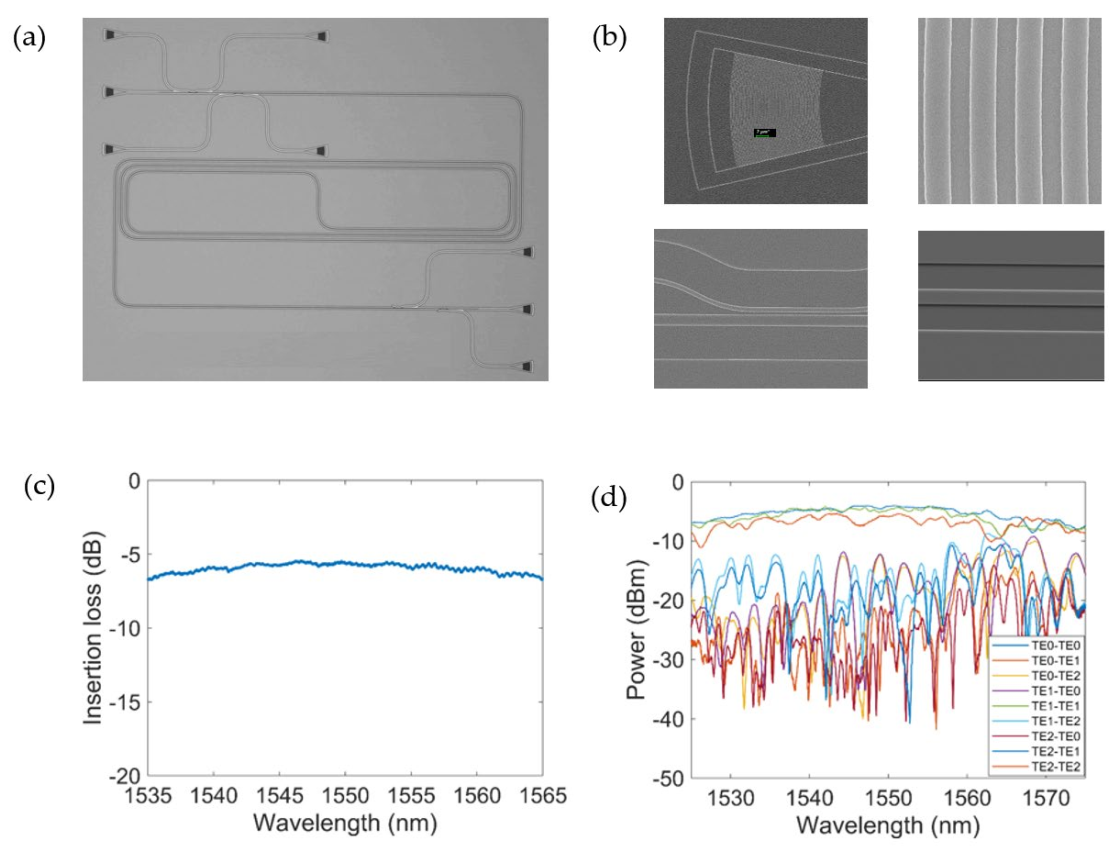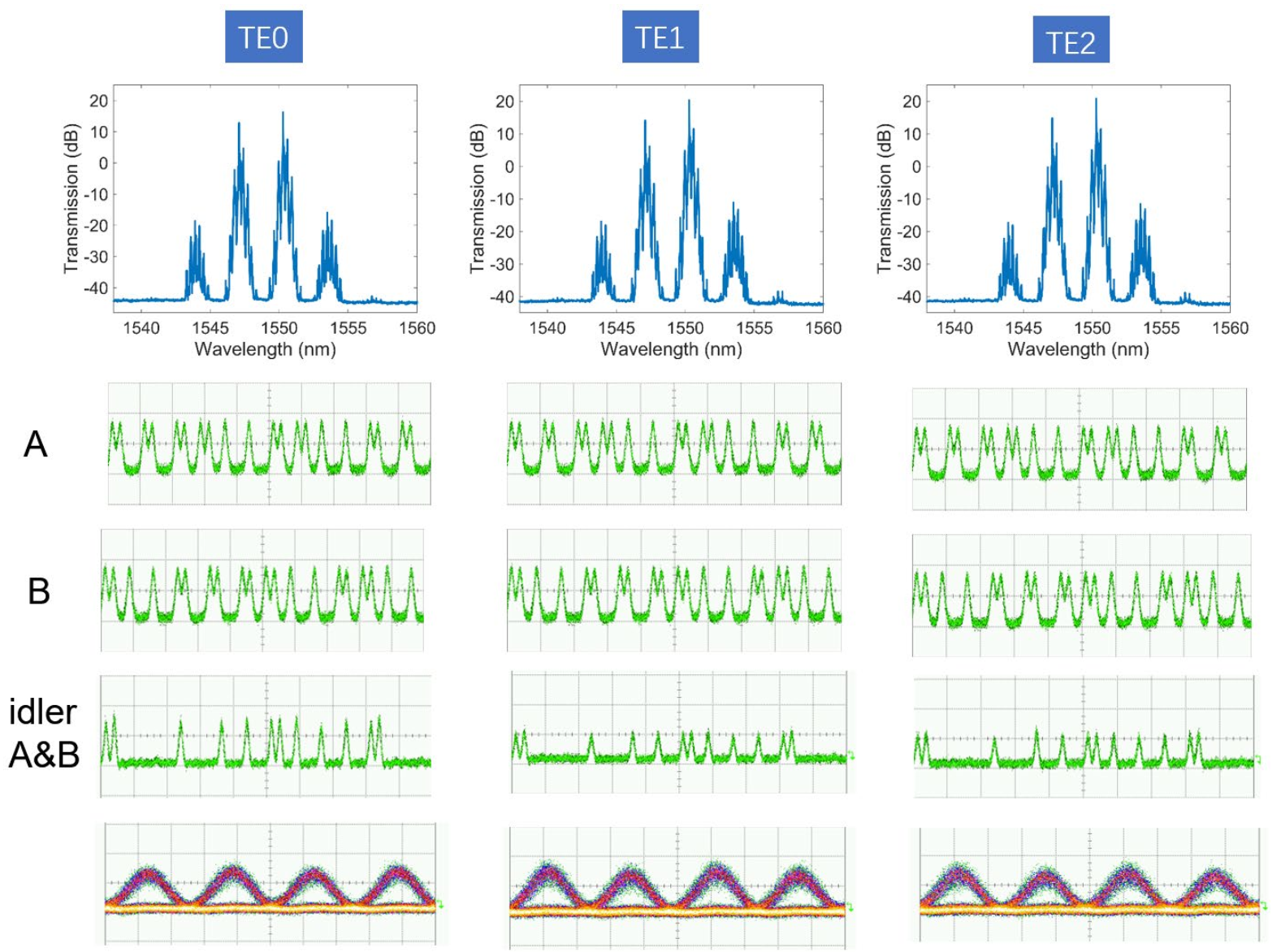3 × 40 Gbit/s All-Optical Logic Operation Based on Low-Loss Triple-Mode Silicon Waveguide
Abstract
:1. Introduction
2. Design of Low-Loss Triple-Mode Nonlinear Waveguide
3. Device Characterizations and System Performance
4. Conclusions
Author Contributions
Funding
Data Availability Statement
Conflicts of Interest
References
- Willner, A.E.; Khaleghi, S.; Chitgarha, M.R.; Yilmaz, O.F. All-Optical Signal Processing. J. Lightwave Technol. 2014, 32, 660–680. [Google Scholar] [CrossRef]
- Almeida, V.; Barrios, C.; Panepucci, R.; Lipson, M. All-optical control of light on a silicon chip. Nature 2004, 431, 1081–1084. [Google Scholar] [CrossRef] [PubMed]
- Bogoni, A.; Poti, L.; Proietti, R.; Meloni, G.; Ponzini, F.; Ghelfi, P. Regenerative and reconfigurable all-optical logic gates for ultra-fast applications. Electron. Lett. 2005, 41, 435–436. [Google Scholar] [CrossRef]
- Slavík, R.; Parmigiani, F.; Kakande, J.; Lundström, C.; Sjödin, M.; Andrekson, P.A.; Weerasuriya, R.; Sygletos, S.; Ellis, A.D.; Grüner-Nielsen, L.; et al. All-optical phase and amplitude regenerator for next-generation telecommunications systems. Nat. Photonics 2010, 4, 690–695. [Google Scholar] [CrossRef]
- Tucker, R.S.; Eisenstein, G.; Korotky, S.K. Optical time-division multiplexing for very high bit-rate transmission. J. Lightwave Technol. 1988, 6, 1737–1749. [Google Scholar] [CrossRef]
- Yates, J.M.; Rumsewicz, M.P.; Lacey, J. Wavelength converters in dynamically-reconfigurable WDM networks. IEEE Communi-Cations Surv. Tutor. 1999, 2, 2–15. [Google Scholar] [CrossRef]
- Dai, D.; Wang, J.; Shi, Y. Silicon mode (de)multiplexer enabling high capacity photonic networks-on-chip with a single-wavelength-carrier light. Opt. Lett. 2013, 38, 1422–1424. [Google Scholar] [CrossRef] [PubMed]
- Richardson, D.J.; Fini, J.M.; Nelson, L.E. Space-division multiplexing in optical fibres. Nat. Photonics 2013, 7, 354–362. [Google Scholar] [CrossRef] [Green Version]
- Uematsu, T.; Ishizaka, Y.; Kawaguchi, Y.; Saitoh, K.; Koshiba, M. Design of a Compact Two-Mode Multi/Demultiplexer Consisting of Multimode Interference Waveguides and a Wavelength-Insensitive Phase Shifter for Mode-Division Multiplexing Transmission. J. Light. Technol. 2012, 30, 2421–2426. [Google Scholar] [CrossRef]
- Driscoll, J.B.; Grote, R.R.; Souhan, B.; Dadap, J.I.; Lu, M.; Osgood, R.M. Asymmetric Y junctions in silicon waveguides for on-chip mode-division multiplexing. Opt. Lett. 2013, 38, 1854–1856. [Google Scholar] [CrossRef] [PubMed]
- Xing, J.; Li, Z.; Xiao, X.; Yu, J.; Yu, Y. Two-mode multiplexer and demultiplexer based on adiabatic couplers. Opt. Lett. 2013, 38, 3468–3470. [Google Scholar] [CrossRef] [PubMed]
- Wang, J.; He, S.; Dai, D. On-chip silicon 8-channel hybrid (de)multiplexer enabling simultaneous mode- and polarization-division-multiplexing. Laser Photonics Rev. 2014, 8, L18–L22. [Google Scholar] [CrossRef]
- Ding, Y.; Jing, X.; Ou, H.; Peucheret, C. Mode-selective wavelength conversion based on four-wave mixing in a multimode silicon waveguide. Opt. Express 2013, 22, 127–135. [Google Scholar] [CrossRef] [PubMed] [Green Version]
- Ying, Q.; Xiang, L.; Ming, L.; Chen, D.; Wang, J.; Xu, J.; Yang, Q.; Yu, S. Mode-selective wavelength conversion of OFDM-QPSK signals in a multimode silicon waveguide. Opt. Express 2017, 25, 4493. [Google Scholar]
- Wang, J.; Luo, M.; Qiu, Y.; Li, X.; Gong, J.; Xu, J.; Yang, Q.; Zhang, X. Dual-channel AND logic gate based on four-wave mixing in a multimode silicon waveguide. IEEE Photonics J. 2017, 9, 1–6. [Google Scholar] [CrossRef]
- Wang, Y.; Yang, H.; Dong, Z. Highly Nonlinear Organic-Silicon Slot Waveguide for Ultrafast Multimode All-Optical Logic Operations. IEEE Photonics J. 2020, 12, 1–12. [Google Scholar] [CrossRef]
- Dong, P.; Qian, W.; Liao, S.; Liang, H.; Kung, C.-C.; Feng, N.-N.; Shafiiha, R.; Fong, J.; Feng, D.; Krishnamoorthy, A.V.; et al. Low loss shallow-ridge silicon waveguides. Opt. Express 2010, 18, 14474–14479. [Google Scholar] [CrossRef] [PubMed]
- Badri, S.H.; Saghai, H.R.; Soofi, H. Polymer multimode waveguide bend based on a multilayered Eaton lens. Appl. Opt. 2019, 58, 5219–5224. [Google Scholar] [CrossRef] [PubMed] [Green Version]
- Jiang, X.; Hao, W.; Dai, D. Low-loss and low-crosstalk multimode waveguide bend on silicon. Opt. Express 2018, 26, 17680. [Google Scholar] [CrossRef] [PubMed]
- Agrawal, G. Nonlinear Fiber Optics; Academic Press: Cambridge, MA, USA, 2013; pp. 27–56. [Google Scholar]






| Author | Structure | Supported Mode Numbers | Logic Operation | Experiment | Signal Rate | Ref. | Year |
|---|---|---|---|---|---|---|---|
| Yunhong Ding et al. | Silicon waveguide | 2 | Wavelength conversion | Yes | 2 × 40 Gb/s | [13] | 2013 |
| Jiamin Wang et al. | Silicon waveguide | 2 | AND | Yes | 2 × 5 Gb/s | [15] | 2017 |
| Yonghua Wang et al. | Organic-silicon slot waveguide | 2 | Addition, subtraction | No | 2 × 640 Gb/s | [16] | 2020 |
| Our work | Silicon ridge waveguide | FWM | AND | Yes | 3 × 40 Gb/s |
Publisher’s Note: MDPI stays neutral with regard to jurisdictional claims in published maps and institutional affiliations. |
© 2022 by the authors. Licensee MDPI, Basel, Switzerland. This article is an open access article distributed under the terms and conditions of the Creative Commons Attribution (CC BY) license (https://creativecommons.org/licenses/by/4.0/).
Share and Cite
Hu, Y.; Yang, Z.; Chen, N.; Hu, H.; Zhang, B.; Yang, H.; Lu, X.; Zhang, X.; Xu, J. 3 × 40 Gbit/s All-Optical Logic Operation Based on Low-Loss Triple-Mode Silicon Waveguide. Micromachines 2022, 13, 90. https://doi.org/10.3390/mi13010090
Hu Y, Yang Z, Chen N, Hu H, Zhang B, Yang H, Lu X, Zhang X, Xu J. 3 × 40 Gbit/s All-Optical Logic Operation Based on Low-Loss Triple-Mode Silicon Waveguide. Micromachines. 2022; 13(1):90. https://doi.org/10.3390/mi13010090
Chicago/Turabian StyleHu, Yuhang, Zihao Yang, Nuo Chen, Hanwen Hu, Bowen Zhang, Haofan Yang, Xinda Lu, Xinliang Zhang, and Jing Xu. 2022. "3 × 40 Gbit/s All-Optical Logic Operation Based on Low-Loss Triple-Mode Silicon Waveguide" Micromachines 13, no. 1: 90. https://doi.org/10.3390/mi13010090





